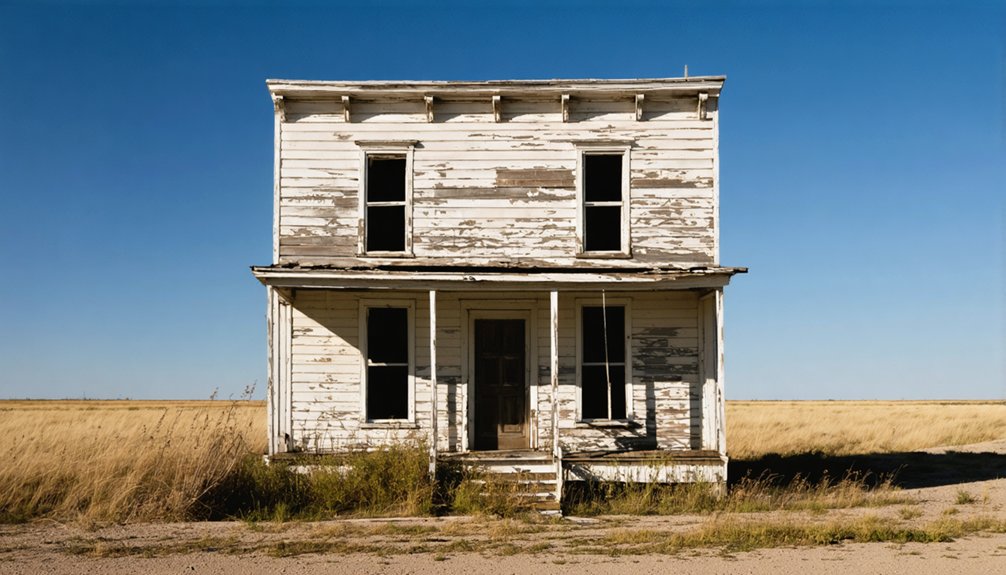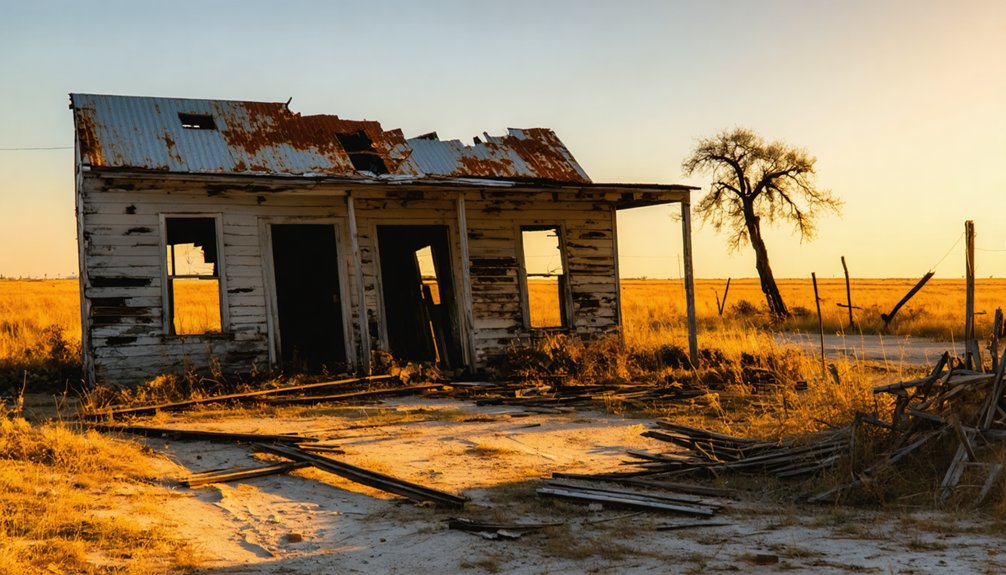You’ll find Provident City‘s haunting remains in Colorado County, Texas, where ambitious land speculators lured 500 Midwestern families in 1909 with false promises of agricultural prosperity. The settlement briefly thrived with stores, banks, and a cannery, but inadequate soil and missing railroad connections led to its rapid decline. By 1949, only 30 residents remained. Today, the historic Provident City Hotel stands alone at County Roads 190 and 248, guarding countless stories of frontier dreams and disappointments.
Key Takeaways
- Provident City, Texas was established in 1909 through misleading marketing campaigns that attracted 500 Midwestern families to buy small farming plots.
- The town rapidly grew to include stores, banks, and a cannery, but failed due to poor soil conditions and lack of railroad access.
- Population declined from 500 families to just 30 residents by 1949 as agricultural challenges and World War I drove settlers away.
- The historic Provident City Hotel remains the only surviving structure, now serving as headquarters for Hancock Ranch.
- Located at County Roads 190 and 248, the ghost town represents failed pioneer settlement dreams in early 20th-century Texas.
The Birth of a Prairie Dream (1909)
Three events marked the ambitious birth of Provident City in 1909: the arrival of Kansas City’s Provident Land Company, their purchase of fertile Goldenrod Prairie lands in Colorado County, Texas, and an aggressive marketing campaign that lured over 500 Midwestern families to buy small farming plots sight unseen.
You’d have found a bustling frontier town emerging from the prairie, complete with a post office by 1910, banks, stores, and the prominent Provident Hotel welcoming land buyers. The town also boasted an active amateur baseball team that brought entertainment to the growing community.
Early settler experiences centered around establishing 5- to 10-acre farms on sandy loam soil that proved less fertile than advertised. While the land could support melons, cucumbers, and vegetables, agricultural challenges soon emerged. Without a railroad connection nearby, the town struggled to efficiently transport goods to larger markets.
The town’s rapid development included a broom factory, cannery, churches, and schools – all evidence of the settlers’ determination to forge a new community in the Texas prairie.
Land Promotion and False Promises
Behind the rapid growth of Provident City lay a carefully orchestrated campaign of deception. Through their publication “The Home Finder,” the Provident Land Company targeted Midwestern families with one of Texas’s most notorious land scams. You’d have found their marketing materials filled with false testimonials and doctored photographs showing bountiful crops that never existed.
The company promoted an enticing vision of farmers achieving success on just ten acres of land. Settler experiences quickly revealed the harsh reality. Families who’d purchased land sight unseen discovered soil unsuitable for farming, no promised railroad connection, and crushing isolation that made commerce nearly impossible. Despite early promise with peak population 500 families, supported by banks, stores, churches and a restaurant, the settlement proved unsustainable.
The company’s dream of agricultural prosperity proved to be nothing more than skillful manipulation. Without viable farmland or transportation infrastructure, residents faced mounting economic hardship.
Life in Early Provident City
As settlers poured into Provident City after 1909, they established a bustling prairie community that briefly supported 500-1,000 residents near Goldenrod and Sandy Creeks.
In 1909, hopeful pioneers carved out a thriving settlement of up to 1,000 souls along two pristine Texas creeks.
You’d have found a self-sufficient town where families worked 5-10 acre plots, growing melons, cucumbers, and vegetables in the sandy loam soil. The local cannery produced “Provident City tomatoes,” while the broom factory provided additional employment.
Community activities centered around baseball games, the Woodmen of the World lodge, churches, and schools. You could shop at grocery stores, furniture shops, and meat markets, or visit the jewelry store and restaurants. The post office and bank served as essential pillars of the developing community.
Despite the initial enthusiasm, agricultural challenges soon emerged. The soil’s limited fertility and geographical isolation made farming difficult, leading many to question their decision to settle in this Texas prairie town.
The Rise and Fall of Commerce
When the Provident Land Company launched its ambitious marketing campaign in 1909, you’d have witnessed a remarkable commercial surge in this nascent Texas prairie town.
Banks, stores, a post office, and even a broom factory sprung up to serve over 500 families who’d purchased plots based on promises of fertile land use.
But you’d soon see how agricultural challenges crushed these dreams. The sandy loam soil proved inadequate for sustainable farming, and the promised railroad connection never materialized beyond a simple roadbed.
Without reliable transportation to larger markets, local businesses couldn’t survive. By World War I, residents began leaving for urban jobs, and the exodus accelerated.
The town’s commerce dwindled until, by 1949, you’d find just 30 residents remaining, with most land converted to ranching operations.
World War I’s Impact on the Settlement
World War I struck a devastating blow to Provident City’s workforce as men departed in large numbers for better-paying jobs in urban centers and military-industrial areas.
You’ll find that this mass exodus severely undermined the town’s farming-based economy, which was already struggling with poor soil conditions and lack of rail access.
The resulting labor shortage accelerated the community’s decline, leading to a population of just 30 residents by 1949 and the closure of the post office in 1952.
The Provident City Hotel still stands as a testament to the town’s more prosperous era, with its distinctive white paint and red brick features.
Like many Texas communities during the war, Provident City experienced a significant shift as residents participated in widespread conservation efforts.
Labor Force Mass Exodus
During the turbulent years of World War I, Provident City experienced a devastating labor force exodus that would seal its eventual fate as a ghost town.
You’d have witnessed the mass departure of working-age men as they left their farms behind for higher-paying industrial and military jobs in Texas’s urban centers. This labor migration stripped the community of its crucial workforce, causing agricultural production to plummet in the sandy soils where melons and cucumbers once flourished.
The economic decline was swift and severe – the population plunged from 500 families to just 150 by 1914. While the war initially provided temporary economic opportunities, most farms were ultimately abandoned as workers never returned. As farms fell into abandonment and community services dwindled, the exodus transformed this once-promising settlement.
The remaining residents couldn’t maintain the town’s essential functions, accelerating its spiral toward extinction.
Community Structure Collapse
As wartime pressures mounted in 1914, Provident City’s fragile community structure crumbled under the weight of multiple destabilizing forces.
You’ll find that WWI’s impact on community dynamics extended far beyond the initial exodus of working men. The arrest of Dr. T.C. Spencer for sedition fractured social cohesion, while federal loyalty enforcement created an atmosphere of suspicion among neighbors.
The town’s isolation, coupled with failed infrastructure promises, left remaining residents feeling trapped and betrayed.
- Your post office and local businesses shuttered as population dwindled
- Your community leaders struggled to maintain basic services
- Your farming families couldn’t sustain operations with severe labor shortages
- Your social gatherings and community events gradually ceased
- Your town’s morale collapsed under anti-American accusations and political tensions
Broken Dreams and Mass Exodus
When the Provident Land Company’s grandiose promises began to unravel in the early 1910s, Provident City’s settlers faced a harsh reality that shattered their dreams of prosperity.
You’d have found the community reeling from broken promises of rich farmland and railroad connections that never materialized.
Instead of thriving orchards, you would’ve seen struggling farmers battling sandy loam soil that could barely sustain basic crops.
The Last Standing Hotel

Standing proudly against the Texas horizon, the Provident City Hotel remains the last vestige of a once-promising settlement, its bright white paint and red brick chimney a stark reminder of early 20th-century ambitions.
Located at the intersection of County Roads 190 and 248, this historic structure stands as a testament to the area’s rich past.
The hotel’s architecture stands as a reflection of your pioneering spirit, having survived prairie fires and economic hardship since 1909.
Like those who built it, this storied hotel weathered both natural disaster and financial ruin, standing defiantly against time itself.
- You’ll find stately early-1900s design features preserved in remarkable condition
- The building served as both lodging and social hub for land buyers and settlers
- In 1917, locals saved the hotel from a prairie fire using wet burlap sacks
- Today, it’s part of the Hancock family ranch, hosting private events and gatherings
- The hotel’s survival, while the town vanished, symbolizes both broken dreams and enduring Texas resilience
The structure you’re seeing isn’t just a building – it’s a rare window into Texas settlement history, telling stories of ambition, community, and survival.
Modern Legacy as a Texas Ghost Town
Though Provident City’s ambitious dreams faded into the Texas prairie, its legacy endures through the town’s sole surviving structure and its cautionary tale of early 20th-century land speculation.
Today, you’ll find the Provident City Hotel standing as a monument to this once-thriving community, now serving as the headquarters for Hancock Ranch. While preservation challenges limit public access, the site’s cultural significance remains strong, drawing historians and photographers interested in Texas ghost towns.
The town’s story lives on through historical markers and Texas State Historical Association documentation, reminding you of the risks early settlers faced.
From a bustling population of 500 families to just 30 residents by 1949, Provident City’s transformation into ranchland illustrates the harsh realities of pioneer settlement and serves as a powerful symbol of Texas’ ever-evolving landscape.
Frequently Asked Questions
What Happened to the Original Land Records and Deeds From Provident City?
After 500+ families abandoned their land ownership claims, you won’t find clear historical preservation of the original deeds – they’re likely scattered between county archives, private ranch records, or lost entirely.
Were There Any Documented Deaths or Burials in Provident City?
You’ll find it challenging to confirm deaths or burials since burial records and death certificates from Provident City haven’t been preserved. Most settlers likely returned to their Midwestern homes or moved elsewhere.
Did Any Descendants of Original Settlers Return to Visit the Site?
Time erases all traces. You won’t find documented evidence of descendant visits or family reunions at the site – private ownership since the 1950s and limited public access have prevented confirmed returns by settler families.
What Crops Were Actually Successfully Grown During Provident City’s Brief Existence?
You’ll find they successfully grew a limited crop variety despite agricultural challenges – mainly melons, cucumbers, onions, and cabbage. The sandy loam soil especially favored melon and cucumber production.
How Did Native Texans Interact With the Midwestern Settlers in Provident City?
Previously present peoples had practically passed from the picture by 1909. You won’t find records of cultural exchange or land disputes between natives and Midwestern settlers in Provident City’s brief existence.
References
- https://tpwmagazine.com/archive/2023/nov/ed_1_journal/
- https://www.youtube.com/watch?v=ofy-Z86SYu0
- http://www.stxmaps.com/go/texas-historical-marker-site-of-provident-city.html
- https://toasttopost.com/the-provident-city-hotel/
- https://allacrosstexas.com/texas-ghost-town.php?city=Providence
- https://en.wikipedia.org/wiki/List_of_ghost_towns_in_Texas
- https://www.texasescapes.com/CentralTexasTownsSouth/Provident-City-Texas.htm
- http://www.lavacacountytoday.com/lifestyle/provident-city-town-built-empty-promises
- https://www.tshaonline.org/handbook/entries/provident-city-tx
- https://en.wikipedia.org/wiki/Provident_City



